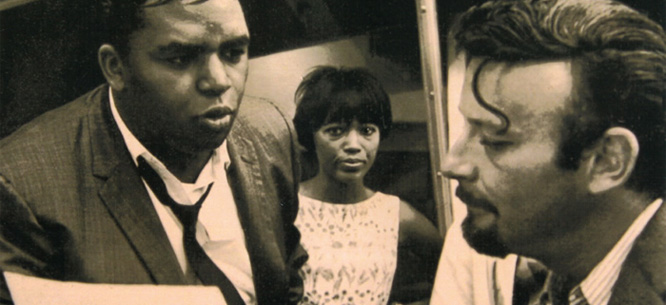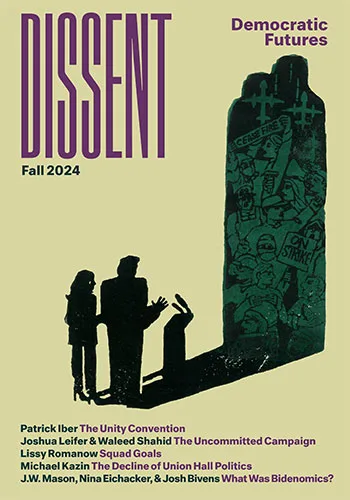Rock Against Racism
Rock Against Racism
Rock-and-roll fans tend to see the rock culture of the 1950s and ‘60s as both a reinvention of American popular music and a force for self-expression and liberal culture. Two new books show what this account leaves out: rock and roll’s frontal assault on American racism.

Here Comes The Night: The Dark Soul of Bert Berns and the Dirty Business of Rhythm and Blues
by Joel Selvin
Counterpoint Press, 2014, 320 pp.
Johnny Cash: The Life
by Robert Hilburn
Little, Brown and Company, 2013, 688 pp.
“When they say ‘we want our America back,’ what the fuck do they mean?” So goes the chorus of a Jill Sobule song. Many rock-and-roll fans have long believed that America’s true soul is very different from the narrow America of the Tea Party’s imagination. Instead, they believe in what Bruce Springsteen once called “the country we carry in our hearts,” a place where personal freedom exists in harmony with egalitarian inclusiveness—a place that is best glimpsed through some of America’s music.
Over the decades the rock-and-roll business grew to encompass all sorts of dark and misogynistic pretenders (and even a few right-wingers such as Ted Nugent), but rock romanticists see the rock culture of the 1950s and ‘60s as both a reinvention of American popular music and a force for self-expression and liberal culture. This idea is richly explored in two new books: Joel Selvin’s Here Comes the Night: The Dark Soul of Bert Berns and the Dirty Business of Rhythm and Blues and Robert Hilburn’s Johnny Cash: The Life.
Selvin’s downbeat title is somewhat deceptive because his book is really an exhaustively researched love letter to an era of R&B and rock and roll in the early 1960s that created pop classics and directly inspired the Beatles, the Rolling Stones, and subsequent decades of rock-and-roll musicians. Rock and roll’s influence over western values included a celebration of all forms of sexuality and an embrace of marginal figures, which in turn broadened cultural definitions of success and glamour. But during its early decades, there was no more important subtext to rock culture than its frontal assault on American racism.
Selvin notes that 1954, the year of Brown v. Board of Education, was “the same year that rock and roll emerged as a force. Rock and roll was the desegregation of the Hit Parade.” 1954 was indeed the year of Elvis Presley’s first single “That’s All Right (Mama)” and Bill Haley and the Comets’ transformative “Rock Around the Clock,” but the first African-American rock-and-roll musicians who also pulled in white listeners actually emerged the following year, in 1955, when Chuck Berry and Little Richard had their first pop hits.
Many civil rights leaders agree that rock and roll was a central cultural force for racial integration. Congressman John Lewis, who participated in the Freedom Rides and who was the youngest person to speak at the March on Washington in 1963, remarked, “if it hadn’t been for music . . . the Movement would have been like a bird without wings.” In the documentary Muscle Shoals, record producer Rick Hall recalls that at the same time that Governor George Wallace was fervently preaching racial segregation in one part of Alabama, integrated groups of musicians were making records with Percy Sledge and Aretha Franklin at Hall’s FAME Studios in another.
However, widespread acceptance of integration occurred on a truly mass level in the heart and soul of flyover country only when white teen audiences became enthralled with black music and when blacks and whites starting dancing together on American Bandstand and other cheesy rock TV shows of the era. As Julian Bond, the veteran civil rights activist, writes, “the history of the music is also a history of cultures joining together.”
Bert Berns, a smart and charming Jewish street kid from the Bronx, became one of the great songwritersand producers of the early years of rock. He worked closely with the Drifters, Solomon Burke, the Isley Brothers, the McCoys, and Van Morrison, among others. His parents had only a limited education, but they did have a lefty streak. They named their son after Bertrand Russell, the famous British philosopher, author, and lifelong pacifist.
During its early decades, there was no more important subtext to rock culture than its frontal assault on American racism.
Because R&B was shunned by major labels, a number of independently owned companies run by music-business outcasts had sprung up in the years after rock and roll burst onto America’s pop scene in 1954. By 1960, the market share of the three biggest record companies—Columbia, RCA Victor, and Decca—declined from over 90 percent to less than a third. Berns did most of his work for Atlantic Records, which was run by Ahmet and Nesuhi Ertegun and Berns’s mentor, Jerry Wexler. Selvin quotes Ben E. King fondly referring to the Erteguns and Wexler as “a better class of thieves.” (For insight into Wexler’s version of the romance of R&B and rock-and-roll roots, check out the wonderful four-part interview he did for the Grammy Foundation when he was in his mid-eighties—old enough to have perspective but still razor sharp.)
While Selvin makes Berns the centerpiece of his book, Here Comes The Night is really a broader history of an entire era in New York’s R&B business. Selvin describes the work and personalities of songwriters such as Jerry Leiber and Mike Stoller, Carole King and Gerry Goffin, Doc Pomus and Mort Shuman, Ellie Greenwich and Jeff Barry, and the producer (and later murderer) Phil Spector.
Also prominently featured in Selvin’s demi-monde are Mafia figures who were involved with the record business, including Tommy Eboli and Sonny Franzese and Morris Levy, the record executive best known for his gangster connections. Criminals like these had previously bankrolled many of the talent agencies that provided entertainment for speakeasies during prohibition and, later, in Las Vegas. The character of Johnny Fontane, the gangster-dependent singer in The Godfather, was probably based on Frank Sinatra.
The good news is that the mob would invest in culture that the corporate world disdained. Some otherwise sociopathic killers had sentimental attachments to certain artists and functioned more as patrons than as businessmen. The bad news is that the mob frequently enforced unfair deals with talent and the people around them with the threat of violence and death, engendering a cynicism in the music business even more corrosive than Wall Street’s.
Aside from such shady figures, the business of rock and roll in which Bert Berns thrived was a milieu where songwriters ruled and producers, arrangers, and studio musicians were more responsible for the sound than most lead singers. As Selvin explains, “In 1960, Berns entered an enchanted village inhabited by a tribe of crazy geniuses. They made records and had no idea they were developing an entire school of art. . . . They collaborated, they competed and they copied each other; they stole from one another, they ate and drank together and used some of the same musicians and arrangers on records, which they made at the same studios [mainly 1619 Broadway, “the Brill Building” and 1650 Broadway]. . . . They were tough, desperate men . . . bottom feeders of the New York music world, hucksters and grifters.”
Berns’s aesthetic resonated strongly with the next and bigger wave of rock and roll. Janis Joplin memorably covered Berns’s songs “Piece Of My Heart” and “Cry Baby.” The Beatles covered Berns’s “Twist and Shout,” the hardest-rocking song of their early work. Andrew Loog Oldham, the first producer and manager of the Rolling Stones, selected three Berns songs for inclusion in the early Stones repertoire (“Under The Boardwalk,” “Everybody Needs Somebody to Love,” and “Cry To Me”).
The idea that any of these records were “art” or “self-expression” would have been laughed out of any office in the Brill Building. With the notable exceptions of Ray Charles and Chuck Berry, there were few singer-songwriters in the early years of R&B-driven rock and roll. The kind of creative angst Bob Dylan, John Lennon, and others would soon infuse into rock and roll had no place there. The only goal of the crowd Selvin describes was to sell records, to anticipate where teenage tastes would shift next.
But paradoxically, as with many of the Hollywood films of the 1930s and ‘40s produced by crude and avaricious moguls such as Harry Cohn, the straitjacket of commercial demands helped to impose discipline on the wild creativity of the streets. Great and enduring music was produced both because of as well as in spite of the mercenary currents that motivated it.
At the same time, down in supposedly conservative Tennessee, Johnny Cash was becoming a multi-dimensional auteur. He was introduced to America as a rock and pop artist with his hit “I Walk The Line,” released on Sun Records within the same brief period that the label introduced Elvis Presley, Jerry Lee Lewis, and Carl Perkins. By the end of the 1950s, the other Sun artists had fallen into a creative rut. But Cash transcended the rockabilly trend that had made him famous. He soon emerged as a country music superstar and almost immediately thereafter took the iconic middle-American credibility he had established and became a part of the early-‘60s folk music movement. Cash maintained relevance in both the country and rock worlds for decades, while his early contemporaries become golden oldies nostalgia acts by the end of the ‘60s.
As Hilburn describes in his definitive account, Cash had a surfeit of his own demons and contradictions. He struggled all his life with an addiction to prescription drugs and at the same time was deeply committed to his personal notion of Christianity. He also had a breadth of artistic vision that nothing in his hardscrabble Arkansas origins could have predicted. As soon as he had his first country hit, “Hey Porter,” Cash unveiled an artistic persona that made him the bane of record-company executive control freaks for the rest of his career. He left Sun Records in 1958 for Columbia Records rather than conform to Sun founder Sam Phillips’s creative constraints, and he released concept albums like Ride This Train years before the Beatles created Sgt. Pepper’s Lonely Hearts Club Band.
Another difference between Cash and his fellow Sun alumni was his political edge. In 1964, Cash had recorded Bitter Tears: Ballads of the American Indian, an homage to Native American singer-songwriter Peter La Farge, and the only 1960s album by a popular artist to shine a light on Native American issues during the ’60s. When conventional country music stations refused to play anything from the album, Cash took out a full-page ad in Billboard reproaching them as cowards.
Columbia tried to discourage him from his live recording At Folsom Prison—the 1968 album that permanently bonded Cash with counter-culture rock fans and revived his career. The label thought that an album recorded in front of convicts would be a commercial flop like Bitter Tears. Instead it became the best-selling album in the country and connected Cash with a new generation of fans who had abandoned top-forty and country radio stations and were instead getting their musical cues from what were then called “underground” FM rock radio stations who played the Folsom Prison album at a time when they ignored the other Sun Records pioneers.
From 1969 to 1971, Cash had his own national TV show and showcased counter-cultural guests such as Pete Seeger, Odetta, Arlo Guthrie, Neil Young, Buffy Sainte-Marie, La Farge, and, of course, Dylan. (In 1969, Dylan, having shocked the austere folk music world by “going electric” a few years earlier, acknowledged the country roots of rock and roll in his album Nashville Skyline, which featured a duet with Johnny Cash on Dylan’s song, “Girl From The North Country.”)
Bert Berns, who would die of congestive heart failure at the age of thirty-eight in 1967, also transcended his commercial beginnings. Rare among the Broadway rock-and-roll crowd, Berns recognized musical auteurs. He signed Neil Diamond, who wrote his own songs, to his indie label Bang Records. (Another exception was Wexler, who while remaining devoted to certain studio musicians, arrangers, and engineers recognized the genius of Ray Charles and Aretha Franklin and gave them the freedom and space to became fully developed artists.) Berns was the only major Broadway producer to visit the UK after the British Invasion. And he produced the album by Van Morrison’s band, Them, which included a now-classic cover of Dylan’s “It’s All Over Now, Baby Blue,” and Berns’s song “Here Comes The Night.” He signed Morrison to a solo contract with Bang Records, and Morrison’s first single for Bang was the now classic “Brown Eyed Girl.”
For most of recorded history, successful musicians have been financially reliant on powerful outside forces, and those forces have not always been benign. Whether or not the Habsburg emperor, Joseph II, really told Mozart that one of his operas had “too many notes,” as depicted in the play and movie Amadeus, there is no question that classical musicians were dependent on the tastes and whims of their patrons. The relationship is not all that different when the benefactor is a drug dealer, a hedge fund operator, or an internet billionaire. One of the remarkable characteristics of the early era of rock and roll was that, for a time, music became so powerful that the values and mores of artists influenced financial elites more than the other way around. To the extent that “the country we carry in our hearts” is to mean more than a decaying empire, we could have worse role models than Bert Berns and Johnny Cash.
Danny Goldberg is the author of Bumping into Geniuses and the President of GoldVE Entertainment, an artist management company whose clients include Steve Earle and Jill Sobule.





